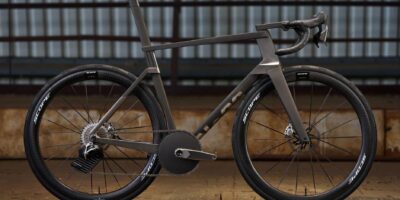The pursuit of aerodynamic speed has defined professional cycling for decades. From revolutionary designs that shocked the peloton to record-breaking machines that redefined what’s possible, here are the most iconic aerodynamic bikes ridden by cycling legends.
The Early Pioneers (1980s-1990s)
Lotus 108 – Chris Boardman, 1992 Olympics
Perhaps the most famous aero bike in history, the Lotus 108 “superbike” designed by Mike Burrows shocked the world when Chris Boardman rode it to Olympic gold in Barcelona. The monocoque carbon fiber frame with internal cable routing and disc wheel integration was decades ahead of its time.
Innovation: Single-piece carbon monocoque construction, no traditional tubes.
Impact: Led to UCI regulation changes banning “non-traditional” frame designs in 1996.
Cervélo Baracchi – Obree/Boardman Era
When Graeme Obree and Chris Boardman were setting hour records, Cervélo emerged with purpose-built time trial machines that emphasized real-world aerodynamics over traditional aesthetics. These bikes pioneered many features we now take for granted.
The Modern Era Begins (2000s)
Trek TTX – Lance Armstrong, Tour de France TTs
Love him or hate him, Armstrong’s dominance in Tour de France time trials brought widespread attention to aerodynamic optimization. The Trek TTX featured early versions of integrated brakes and internal cable routing that would become standard.
Key Features: Kammtail airfoil tubes, integrated brake calipers, adjustable geometry for optimal position.
Specialized Shiv – Team Saxo Bank
The Shiv revolutionized triathlon and time trial bikes by placing hydration and nutrition storage in aerodynamically optimized locations. Wind tunnel testing showed this created less drag than bottles on a standard frame.
The Aero Road Revolution (2010s)
Canyon Aeroad – Movistar Team
When Nairo Quintana and Alejandro Valverde piloted the Aeroad to stage wins in grand tours, it proved aero bikes could climb. The Aeroad balanced aerodynamic gains with acceptable weight, changing the conversation around aero road bikes.
Trek Madone – Fabian Cancellara
Cancellara’s domination of cobbled classics and time trials on various generations of the Madone demonstrated that aero bikes could handle any terrain. The integration of the IsoSpeed decoupler showed aero bikes didn’t have to be uncomfortable.
Record Breakers (2010s-2020s)
Canyon Speedmax – Jan Frodeno, Ironman Records
Frodeno’s sub-8-hour Ironman performance involved a heavily customized Speedmax that represented the pinnacle of triathlon aerodynamics. Every element was optimized in the wind tunnel, from cockpit to rear wheel.
Pinarello Bolide TT – Team Ineos
Geraint Thomas and Chris Froome piloted iterations of the Bolide to time trial victories in grand tours. The asymmetric frame design and fully integrated cockpit pushed the boundaries of UCI regulations.
Current Generation Superbikes (2020s)
Factor Ostro VAM – Israel Start-Up Nation
The VAM (Velocità Ascensionale Media – climbing speed) challenged the notion that aero bikes can’t climb. At just 6.9kg in its lightest build while maintaining aero performance, it’s ridden by Chris Froome in his comeback years.
Why it matters: Proves aero and lightweight aren’t mutually exclusive anymore.
Cervélo S5 – Jumbo-Visma
Wout van Aert’s victories across classics, sprints, and time trials on the S5 demonstrate the versatility of modern aero bikes. The V-stem integration and Reserve wheels create a complete aero system.
Specialized Venge – Quick-Step Alpha Vinyl
Though recently discontinued in favor of the Tarmac SL7, the Venge represented Specialized’s aero-at-all-costs philosophy. Fabio Jakobsen’s sprint victories showcased its terminal velocity in bunch sprints.
What These Bikes Taught Us
1. Incremental gains compound: Each generation saved 5-10 watts, but 40 years of development means modern bikes are 100+ watts faster than 1980s machines.
2. Position matters more than equipment: Boardman’s position on the Lotus 108 mattered more than the frame itself.
3. Integration is key: Modern aero bikes work as complete systems – frame, wheels, cockpit, and storage integrated for maximum efficiency.
4. Regulations shape innovation: UCI rules have both limited and inspired creative solutions in aero bike design.
The Future
As we look to 2025 and beyond, the next generation of aero bikes will likely focus on:
- Electronic integration (shifting, suspension, power meters all wirelessly managed)
- Customizable aerodynamics (adjustable features for different race scenarios)
- Computational fluid dynamics making bespoke aero optimization affordable
- 3D-printed titanium and advanced composites pushing weight lower while maintaining aero performance
The bikes that today’s pros ride will seem primitive in 20 years, but they stand on the shoulders of the giants chronicled here – from Boardman’s Lotus to Froome’s Factor, each pushed the boundaries of what’s possible when aerodynamics meets human power.



